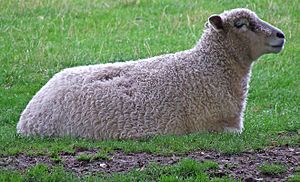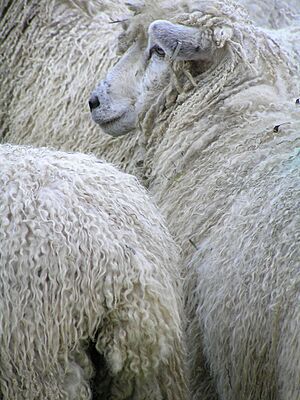Cotswold sheep facts for kids
The Cotswold sheep is a special type of domestic sheep. It comes from the Cotswold hills in the southern part of England. This sheep is known for two main things: its meat and its wool.
Today, the Cotswold sheep is quite rare. In the UK, groups like the Rare Breeds Survival Trust call it a "minority" breed. This means there aren't many of them left.
Contents
What Do Cotswold Sheep Look Like?
Cotswold sheep are usually calm and friendly animals. Most of them have white faces. Sometimes, their faces might have a few light grey or tan hairs mixed in. You might also see small black spots on their legs, ears, or face. But their wool is always white. Their wool is also free of coarse, rough hairs called kemp.
Their hooves are usually black, but they can sometimes have lighter streaks. It's rare for Cotswold sheep to get foot rot, a common hoof problem in sheep. Male Cotswold sheep, called rams, sometimes have small bumps called scurs, but they don't have large horns.
Cotswold sheep don't like to stay in a tight group like some other sheep breeds. They prefer to spread out and graze more evenly across a field. They can live for a long time, often between 10 and 15 years.
History of Cotswold Sheep
Cotswold Sheep in America
Cotswold sheep first came to the United States in 1831. A man named Christopher Dunn brought one Cotswold ram to New York. He wanted to breed it with his English Leicester ewes. The lambs from this cross were so good that it made others want to import more Cotswold sheep.
William Henry Sotham, with help from Erastus Corning, brought many Cotswold sheep from England. These sheep came from the famous flock of William Hewer in Gloucestershire. Another important early group of Cotswold sheep in America came from the Charles Barton Flock. This family had records of their Cotswold sheep going all the way back to 1640!
Like other sheep with long wool, Cotswold sheep were often used to breed with other types of sheep. By 1914, over 760,000 Cotswold sheep were recorded in the US and Canada. People liked them because they added length to the wool of other breeds. They also kept the sheep large and the wool thick.
One big reason Cotswold sheep became popular in the USA was that they didn't need a lot of expensive grain to grow well.
A very large Cotswold sheep named Broadfield's Pride lived in the 1870s. He was born in England and weighed an amazing 445 lb (202 kg)! Some of his lambs grew to weigh 280 to 300 lb (130 to 140 kg) by the time they were one year old.
Black Cotswold Sheep
In 1989, the Black Cotswold was recognized as its own separate breed in the USA. A group called the Black Cotswold Society was created to help farmers raise them. Black Cotswold sheep can be any color, even white, as long as they are related to black sheep. However, the Black Cotswold is not recognized or bred in the UK.
Cotswold Sheep in Britain
Cotswold sheep have been known for their slightly golden wool for a very long time. Writers in England from the late 1500s and early 1600s mentioned this. This golden wool gave them the nickname "Golden Fleece Breed." Dark-colored Cotswold sheep were extremely rare in Britain.
Some old black "Cotswolds" were actually crosses with other breeds. For example, some were mixed with English Leicesters, a breed that often has colored wool.
Ancient Roman Connection
In 1964, a Roman sculpture of a sheep's head was found near Bibury Church in Gloucestershire, England. This sculpture looks a lot like modern Cotswold sheep.
Some experts believe that the Cotswold breed was already living in the Cotswold Hills when the Romans arrived around 54 BC.
Raising Cotswold Sheep
Today, Cotswold sheep are thought to be slow-growing. Giving them too much grain can make them sick with problems like "pulpy kidney" or "gravel" (a kidney stone issue in males).
However, Cotswold sheep are special because they can do well even in places where other long-wool breeds might struggle to find enough food.
Their meat has a very mild flavor. Mutton from Cotswold sheep is much less "gamey" than lamb from many other breeds. People who usually don't like lamb often enjoy Cotswold mutton.
Cotswold lambs are very strong after they are born and dried off. Their heads are small at birth, which makes them easier for the mother sheep to deliver. This happens if the mother isn't overfed during her pregnancy. Cotswold ewes also have a "narrow flank," which helps the lambs come out in the right position during birth.
Most Cotswold ewes produce a lot of milk. This can be a problem if they are overfed and only have one lamb, as it can lead to "pulpy kidney" disease. However, if they get the right shots, their good milk production might mean they could be used for dairy farming.
Because their wool is so long and parts along their back, cold rain can cause health problems. But low temperatures and heavy snow don't usually bother them. Where the wool parts on their back, flies can bite their skin.
Cotswold sheep live a long time. It's common for Cotswold ewes to have twins every year, even when they are over 10 years old.
Cotswold Wool
Cotswold wool is very luxurious, especially when it's prepared by hand using wool combs. This process makes a special type of yarn called "worsted roving." True worsted wool doesn't feel itchy because all the fibers point in the same direction, just like they grew on the sheep. This makes fabric that feels a lot like mohair. In fact, Cotswold wool is sometimes called "poor man's mohair."
Cotswold wool is also incredibly strong. Knitters often add it to the heels and toes of socks to make them last longer. They also use it for the elbows of sweaters. If you wear a sweater made of Cotswold wool in the woods, you won't leave bits of yarn behind. Instead, the strong wool might even pull branches off bushes!
The wool grows about 8 to 12 inches (20 to 30 cm) in a year. If it's not shorn (cut off) in early spring, it can become matted. The wool has a spinning count of 36s to 44s, usually around 40s. Generally, the tighter the curls in the fleece, the finer the wool. The curly locks of Cotswold wool are often sold as material for "Santa Claus Beards."
Cotswold Cloth
According to W. S. Harmer from the British Cotswold Sheep Society, writing in 1892, the Cotswold is the only sheep breed linked to the amazing "cloth of gold" from ancient times. Merchants from Florence, Italy, traveled to England to buy large amounts of this shiny, linen-like wool. They used it for this special cloth as far back as the 13th century.
Cotswold wool was used instead of linen. It was woven with very fine real gold wires to make special clothes for ancient priests and kings. This ancient weaving method is described in the Bible.



